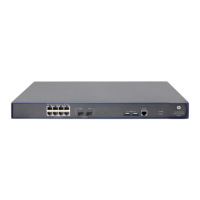195
LLDPDU TLVs fall into the following categories: basic management TLVs, organizationally (IEEE 802.1
and IEEE 802.3) specific TLVs, and LLDP-MED (media endpoint discovery) TLVs. Basic management TLVs
are essential to device management. Organizationally specific TLVs and LLDP-MED TLVs are used for
improved device management. They are defined by standardization or other organizations and are
optional to LLDPDUs.
1. Basic management TLVs
Table 68 li
sts the basic management TLV types in use. Some of them must be included in every
LLDPDU.
Table 68 Basic LLDP TLVs
T
Chassis ID Specifies the bridge MAC address of the sending device.
Mandatory.
Port ID
Specifies the ID of the sending port.
If LLDP-MED TLVs are included in the LLDPDU, the port ID TLV
carries the MAC address of the sending port or the bridge
MAC in case the port does not have a MAC address. If no
LLDP-MED TLVs are included, the port ID TLV carries the port
name.
Time to Live
Specifies the life of the transmitted information on the
receiving device.
End of LLDPDU Marks the end of the TLV sequence in the LLDPDU.
Port Description Specifies the port description of the sending port.
Optional.
System Name Specifies the assigned name of the sending device.
System Description Specifies the description of the sending device.
System Capabilities
Identifies the primary functions of the sending device and the
primary functions that have been enabled.
Management Address
Specifies the management address used to reach higher level
entities to assist discovery by network management, and the
interface number and OID associated with the address.
2. IEEE 802.1 organizationally specific TLVs
Table 69 IEEE 802.1 organizationally specific TLVs
T
Port VLAN ID
Specifies the port's VLAN identifier (PVID). An LLDPDU carries only
one TLV of this type.
Port And Protocol VLAN ID
Indicates whether the device supports protocol VLANs and, if so,
what VLAN IDs these protocols will be associated with. An
LLDPDU can carry multiple different TLVs of this type.
VLAN Name
Specifies the textual name of any VLAN to which the port belongs.
An LLDPDU can carry multiple different TLVs of this type.
Protocol Identity
Indicates protocols supported on the port. An LLDPDU can carry
multiple different TLVs of this type.
DCBX Data center bridging exchange protocol.
The device only supports receiving protocol identity TLVs.

